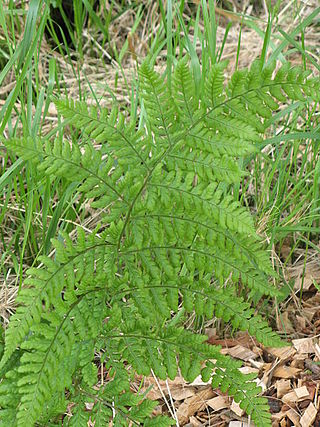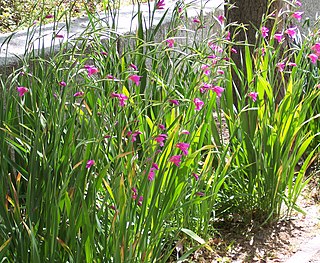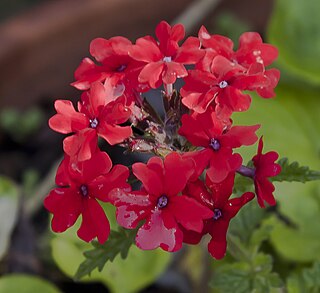
Euphorbia mellifera, the Canary spurge or honey spurge, is a species of flowering plant in the spurge family Euphorbiaceae, native to Madeira and the Canary Islands. It is an evergreen shrub or tree growing to 2.5 m (8.2 ft) tall and broad, with narrow leaves up to 20 cm (8 in) long. In spring it produces brown, honey-scented flowers.

Geranium maderense, known as giant herb-Robert or the Madeira cranesbill, is a species of flowering plant in the family Geraniaceae, native to the island of Madeira. It is sometimes confused with another Madeira endemic, Geranium palmatum.

Verbena, also known as vervain or verveine, is a genus in the family Verbenaceae. It contains about 150 species of annual and perennial herbaceous or semi-woody flowering plants. The majority of the species are native to the Americas and Asia; however, Verbena officinalis, the common vervain or common verbena, is the type species and native to Europe.

Primula elatior, the oxlip, is a species of flowering plant in the family Primulaceae, native to nutrient-poor and calcium-rich damp woods and meadows throughout Europe, with northern borders in Denmark and southern parts of Sweden, eastwards to the Altai Mountains and on the Kola Peninsula in Russia, and westwards in the British Isles.

Glandularia, common name mock vervain or mock verbena, is a genus of annual and perennial herbaceous flowering plants in the family Verbenaceae. They are native to the Americas.

Genista tinctoria, the dyer's greenweed or dyer's broom, is a species of flowering plant in the family Fabaceae. Its other common names include dyer's whin, waxen woad and waxen wood. The Latin specific epithet tinctoria means "used as a dye".

Verbena bonariensis, the purpletop vervain, clustertop vervain, Argentinian vervain, tall verbena or pretty verbena, is a member of the verbena family cultivated as a flowering annual or herbaceous perennial plant. In USA horticulture, it is also known by the ambiguous names purpletop and South American vervain. For the misapplication "Brazilian verbena" see below.

Umbilicus oppositifolius, common names lamb's-tail and gold drop, is a succulent, perennial flowering plant, a species in the genus Umbilicus of the family Crassulaceae. It is endemic to shady mountain areas in the Caucasus.

Verbena hastata, commonly known as American vervain, blue vervain, simpler's joy, or swamp verbena, is a perennial flowering plant in the vervain family Verbenaceae. It grows throughout the continental United States and in much of southern Canada.

Gaultheria mucronata is a species of flowering plant in the family Ericaceae, native to southern Argentina and Chile.

Salix acutifolia, also known as Siberian violet-willow, long-leaved violet willow or sharp-leaf willow, is a species of flowering plant in the family Salicaceae, native to Russia and eastern Asia. It is a spreading, deciduous shrub or tree, growing to 10 m (33 ft) tall by 12 m (39 ft) wide. The young shoots are deep purple with a white bloom. The leaves are narrow, up to 10 cm (4 in) long. The catkins are produced in early spring, before the leaves. Older bark has a fine, netted pattern.

Digitalis ferruginea, the rusty foxglove, is a species of flowering plant in the family Plantaginaceae, native to Hungary, Romania, Turkey and the Caucasus. It is a biennial or short-lived perennial plant growing to 1.2 m, which forms a rosette of oblong dark green leaves and carries spikes of brown, tubular flowers in summer.

Chrysojasminum humile, the Italian jasmine or yellow jasmine, is a species of flowering plant in the family Oleaceae, native to Afghanistan, Tajikistan, Pakistan, Nepal, Burma (Myanmar), the Himalayas and south west China. The species is widely cultivated and reportedly naturalized in Greece, Sicily and the former Yugoslavia.

Heliopsis helianthoides is a species of flowering plant in the family Asteraceae, known by the common names rough oxeye, smooth oxeye and false sunflower. It is native to eastern and central North America from Saskatchewan east to Newfoundland and south as far as Texas, New Mexico, and Georgia.

Veronica austriaca, the broadleaf speedwell, large speedwell, Austrian speedwell, or saw-leaved speedwell, is a species of flowering plant in the plantain family Plantaginaceae, native to northern temperate Europe. Growing to 90 cm (35 in) tall by 60 cm (24 in) broad, it is a mound-forming herbaceous perennial, with deeply toothed leaves and erect spikes of bright blue flowers throughout summer.

Coronilla valentina, the shrubby scorpion-vetch, scorpion vetch or bastard senna, is a species of flowering plant in the genus Coronilla of the legume family Fabaceae, native to the Mediterranean Basin, and introduced into Kenya and the United States. It is an evergreen shrub growing to 80 cm (31 in) tall and wide, with pea-like foliage and fragrant, brilliant yellow flowers in spring and summer, followed by slender pods. Linnaeus observed that the flowers, remarkably fragrant in the daytime, are almost scentless at night.

Dryopteris dilatata, the broad buckler-fern, is a robust species of deciduous or semievergreen fern in the family Dryopteridaceae, native to Europe, particularly western and central Europe. In southern Europe, it is mostly found in mountainous regions. It is also found between the Black Sea and the Caspian Sea. It grows to 90 cm (35 in) tall by 120 cm (47 in) wide, with dark green tripinnate fronds, the ribs covered in brown scales.

Gladiolus communis, the eastern gladiolus, or common corn-flag, is a species of flowering plant in the family Iridaceae, native to temperate northern Africa, western Asia and southern Europe, from the Mediterranean to the Caucasus, and widely naturalised in frost-free locations elsewhere – such as coastal parts of the southwestern British Isles.

Pteris cretica, the Cretan brake, ribbon fern, or Cretan brake fern, is a species of evergreen fern in the family Pteridaceae, native to Europe, Asia and Africa.

Verbena peruviana, the Peruvian mock vervain, is a species of flowering plant in the family Verbenaceae. It is native to Bolivia, southern Brazil, northern Argentina, Paraguay, and Uruguay, but not Peru, and has been introduced to scattered locations elsewhere, including the former Czechoslovakia, the US state of Illinois, and the Leeward Islands. Under the synonym Glandularia peruviana, its cultivar 'Balendpibi' has gained the Royal Horticultural Society's Award of Garden Merit.




















